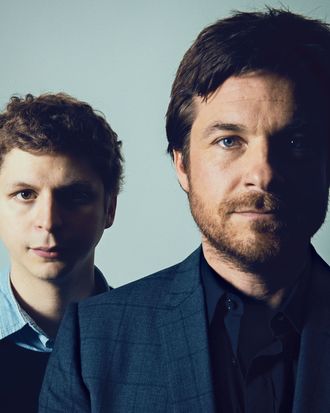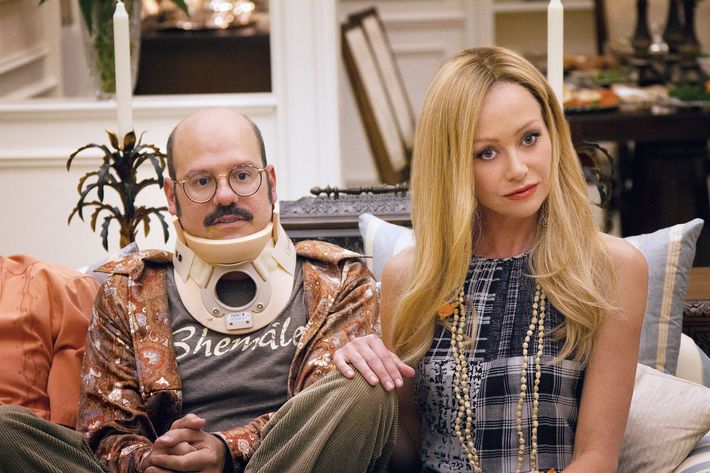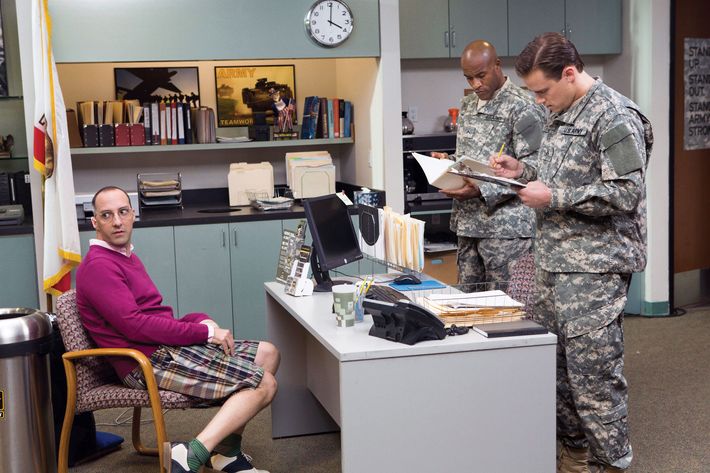
The final four episodes of Arrested Development—the cult comedy that aired on Fox from 2003 to 2006, launched (or relaunched) the careers of Jason Bateman, Michael Cera, and Will Arnett, and is considered one of the great sitcoms of all time (and definitely the best to ever feature a subplot about testicles being mistaken for maps of Iraq)—were broadcast in one two-hour block, back-to-back, with only slightly more fanfare than if they had been screened by projector off the back of a moving truck. After slashing the final season’s number of episodes from 22 to thirteen and hiding the program from sweeps week, Fox dumped the last four shows—starting with “Fakin’ It” (featuring Judge Reinhold’s legal reality show, Judge Reinhold) and ending on “Development Arrested,” with Michael and his son leaving that crazy family once and for all—on February 10, 2006. Also that night: the Winter Olympics opening ceremonies, in all their glory, on NBC. The timing was not a coincidence.
As an Arrested Development obsessive, I remember watching those last four episodes in an attic in suburban Ohio, while everyone else in the house watched the pageantry in Turin like normal people. There was no Hulu, no Twitter, no compendium of episode recaps to scour in the morning. I just saw Ron Howard, who had been the show’s invisible narrator, actually appear and, playing himself, say the show’s last line—that tantalizing and self-mocking “Maybe a movie.” Then it was over, like it had never happened. It was an ignominious and, of course, entirely apt finish. Arrested Development, the story of possibly the most dysfunctional family ever produced by American wealth, was replaced on the Fox schedule by Skating With Celebrities, a fate so bizarre and perfect it sounds like something the show would have come up with on its own.
Now, of course, being an Arrested Development fan is cool, which is why the show is returning on Netflix for fifteen episodes, to be released on May 26. This is unfathomable in every way for those few of us who watched the show in isolation back in the day—but also entirely to our credit. The resurrection is the direct result of the happy-go-tireless advocacy of a small but rabid group of superfans who have become, over the seven years since the show went off the air, a kind of cult—the best kind of cult. Amazingly, executives have actually listened to us, even thinking it was good business sense to do so.
Arrested Development is not the only show to have inspired feverish loyalty—it’s a spirit shared by countless fans who have had their favorite shows cut short in years past, from Freaks and Geeks to Firefly. But the Arrested Development cult was different: more crazed, more committed, and ultimately more powerful. Handily, it also featured many, many members of the entertainment media, which means anytime any actor on the show did any interview—particularly Cera and Bateman, whose careers took off after the show went dark—they were inevitably asked about a reunion. This led to show creator Mitch Hurwitz and crew stoking speculation, even tossing out red herrings like Cera’s not wanting to be a part of it. Actors like David Cross and Portia de Rossi got in the habit of showing a little Arrested Development leg as a way to promote lesser, duller projects in interviews that would inevitably excite their Arrested Development base. And the return of the show went from pipe dream to fanciful notion to intriguing possibility to tantalizingly close likelihood to locked-in full season almost entirely in the hands of fans. The cult became so strong that not only did fans manage to bring the show back, they also tried—on fan sites and comment threads and in e-mail campaigns—to make sure some of their favorite smaller characters returned, too. (Steve Holt!)

The world into which the first three seasons of Arrested Development were released is dramatically different from the one we live in now. “I was doing a show that was all about rewatchability before there was technology that really provided that opportunity—before DVRs, etc.,” Hurwitz said in an interview with Vulture last year. “In retrospect, it was more than audacious; it was foolish. ”
This is a key point, sort of the insane, futile genius of Arrested Development—a show that demanded the kind of giddy Internet dissections we do regularly now, but before there was any real forum in which to conduct them. The show was full of crazily subtle in-jokes you had to watch every episode over and over to catch, from the out-of-season seasonal clothing the Bluths made their housekeeper wear to Cloudmir Vodka, a brand that shows up in the background of at least a half-dozen scenes. We’d catch those immediately now, and every different Bluth family member’s chicken impression would be gif’d within seconds of airing. It was a show made to be looped and recapped and deep-dived into, anticipating the current cultural moment without ever being able to benefit from it. A show for 2013 made in 2005.
Then, of course, we knew not of GIFs. What we did know was that what Arrested Development was doing was so revolutionary and different it felt like public access, and it was on freaking Fox. (I remember Joe Buck and Troy Aikman plugging Arrested Development during the NFC Championship Game, for crying out loud.) And obsessing over Arrested Development made us feel better, smarter, cooler than all those dopes busy watching Two and a Half Men. In this way, Arrested Development didn’t just foretell the viewing culture of 2013; it might have created it. The television world is so fractured and niche now that the shows we watch have become an important signifier of who we are—who we want to be seen as, anyway. I’m a Louie person but not a Community person. I’m a Breaking Bad person but not a Homeland one. And if I saw on your Facebook wall that you were an Arrested Development fan, well, I could bet you and I were gonna get along just fine. Which we did: That incredible camaraderie within the accidental, haphazard, seemingly pointless community of Arrested Development obsessives is one large reason the show eventually got resurrected. That kind of collective action would have been insane to imagine in 2006. That a tiny fan base could rally to revive a show a season after it went off the air? Maybe. But seven years later? It feels like a major evolutionary event.
In a documentary released this month about the show and its maniacal fan base, Hurwitz tells the directors (two maniac fans themselves) that “there are more fans in this movie than there are outside this movie.” That sentiment obviously applied in 2006—when Arrested Development finished 123rd in the ratings, tied with WB’s Beauty and the Geek and behind the Pamela Anderson sitcom Stacked—but that doesn’t necessarily mean it doesn’t still apply now. The show sold decently in full-season boxed sets, but of course this was back when (a) there weren’t many full-season boxed sets to compete with, and (b) people watched DVDs. We were a niche audience that wanted to live in the Arrested Development universe and would devour every scrap of it. In the years since, deprived of Arrested Development, we’ve grown to appreciate the show more than perhaps we did then … but I’m not sure we’ve grown in number.
Thankfully, in the meantime, the rest of the world has shrunk. The terrible ratings that Arrested Development got back then would be moderately respectable today, now that the media universe has splintered into thousands of different little TLC-size pieces. Its first season, which averaged 6.2 million viewers an episode, would comfortably beat the ratings of any of the shows on NBC’s Thursday-night comedy lineup today and would probably have the network building its whole schedule around it. That final episode of the series, the one buried among the opening ceremonies? More people watched it than the season finale of Breaking Bad. Of course, that doesn’t mean Arrested Development was more popular than we realized. It’s that nothing now is as popular as we think it is. (And that in 2006, a lot of people tuned in to Fox by default, without even realizing it, apparently.)

Which is to say: As geeked out as we all are that Arrested Development has returned, let’s not start pretending that the show is somehow mainstream, that its giddy weirdness could ever be called mainstream. Netflix has already ruled out a second season for the show, though Hurwitz himself has expressed interest. He’s also planning for the Netflix episodes to lead into a movie, and as exciting as that is for me and the rest of us superfans, I can’t imagine the movie ever becoming a hit. It is very possible that Arrested Development is about to be the first show to underperform in three different distribution channels.
Still, this is a fervid, loyal fan base that will follow the show anywhere, from a tiny TV in an Ohio attic to Netflix for a subscription so all 68 episodes can be greedily inhaled in fevered succession. And this, of course, is something Netflix has been counting on. It’s worth it for them, no matter how many new subscribers signed up just to count the days until Arrested Development returns, the ones who will gobble up every episode the minute it hits. And blog about it. And say the word Netflix. (The only question is how difficult it will be to capture gifs from streaming video.) Arrested Development has been an enormous public-relations triumph for Netflix; having a show with the following of Arrested Development instantly legitimized the company’s growing original-programming department in a way that the well-received House of Cards couldn’t. Netflix is now an undeniable and much-admired player, just eighteen months after destroying customer loyalty with its aborted divide-and-relaunch as Qwikster, in large part because of Arrested Development. In that way, it doesn’t really matter how many people watch the show. (This, apparently, will always be Arrested Development’s plight.)
Now, this bit of fan-service show-revival for perhaps the most persistent cult in popular culture is probably not repeatable. (I am not holding my breath for that Party Down movie, let’s say that.) But Arrested Development fans don’t care. Having it back is a dream come true for us, and after waiting around seven years for new episodes, and then somehow actually getting them—it’d be churlish and spoiled, even perverse, to ask for more. So, come May 26, I’m locking myself in my room and not coming out until I’ve watched them all twice: Do not try to contact me or inquire as to my whereabouts. The show’s return is an incredible gift, even if it’s a self-contained one. And who knows? Maybe, now that we live in this bizarre universe so different from the one in which we last saw the Bluths, it’ll be such a huge hit that the Arrested Development crew gets back together every few years, the sitcom Before Sunrise. Maybe Arrested Development will bring in the cash it never did in its first run. If not, though, that’s okay: There’s always money in the banana stand.
*This article originally appeared in the May 20, 2013 issue of New York Magazine.


